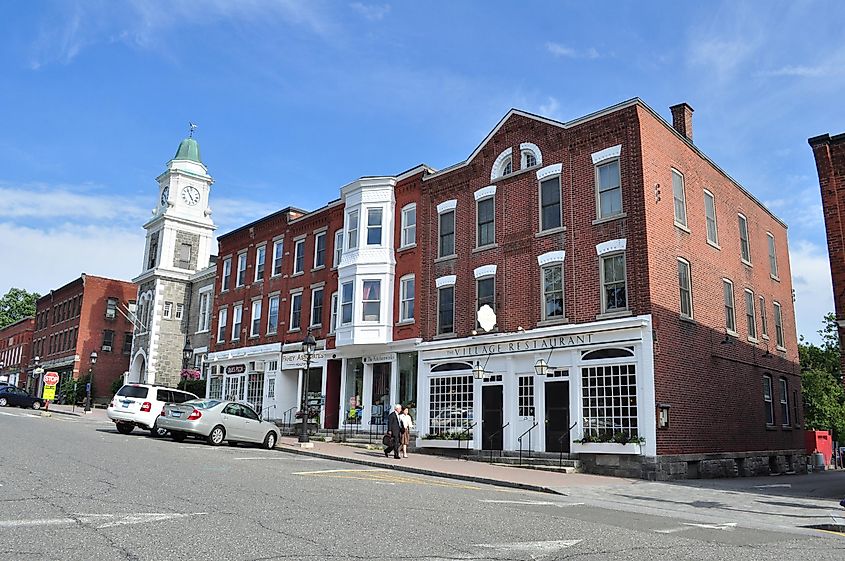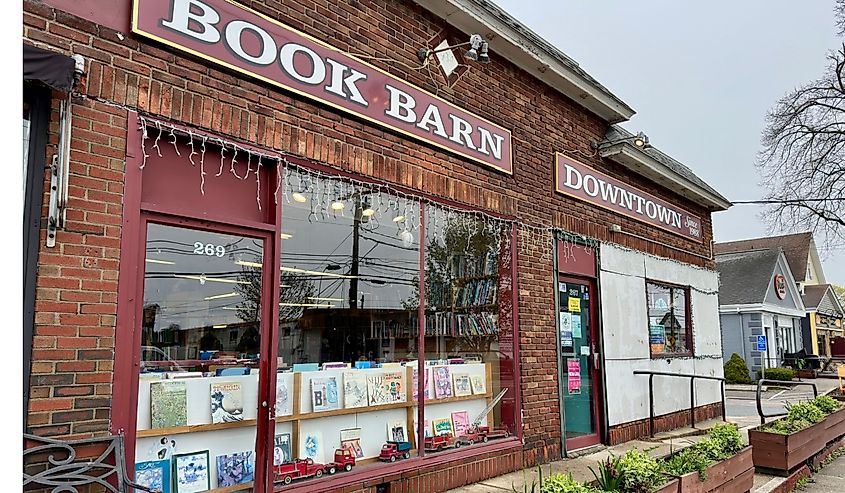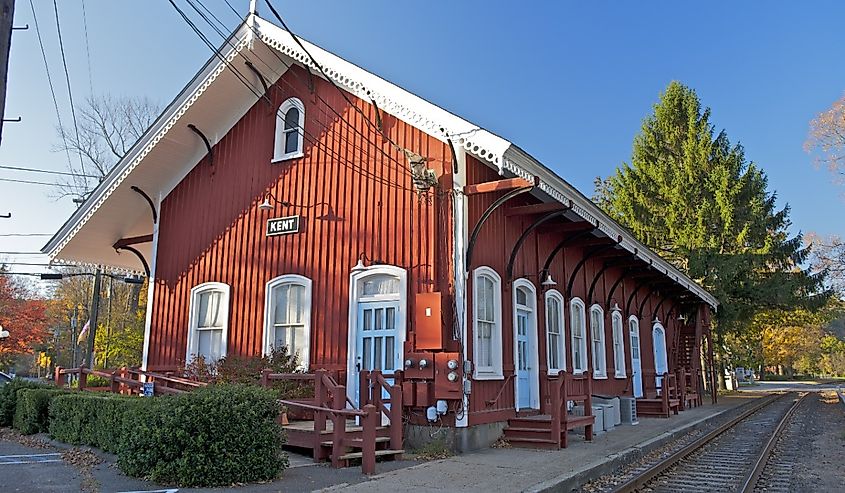Connecticut
8 Loveliest Small Towns to Visit in Connecticut This Summer

From the 250-mile Long Island Sound coastline and rolling Litchfield Hills to the pristine Connecticut River Valley, Connecticut’s sprawling open spaces give it some of the best natural scenery in New England. Tourists from around the country visit to explore exciting outdoor recreation and experience the rich cultural scene. Spread across these idyllic landscapes are little boroughs that are the true lifeblood of the Constitution State. Beyond buzzing metro areas like Hartford and New Haven lie quintessential New England towns capturing the essence of Nutmeg State charm.
These loveliest small towns to visit in Connecticut set the stage for easygoing yet invigorating escapes this summer. From maritime villages to mountain hamlets, explorers will find scenic beauty, local flavor, and true Northeast hospitality in these underrated gems.
Essex
This quaint village on the Lower Connecticut River Valley was once dubbed “The Perfect Small American Town,” a credit to stunning natural beauty, easygoing atmosphere, and quintessential rural feel. It offers exciting experiences to fuel your summer itinerary, such as relaxed sightseeing boat cruises on the Connecticut River curated to your satisfaction, courtesy of RiverQuest. The tour includes stops at major town attractions, with the Connecticut River Museum as the highlight. This wonderful facility offers three floors of rare exhibits, including art and artifacts chronicling the town’s shipbuilding heritage from as far back as 1733.
Tourists will find the Safe Harbor Essex Island appealing thanks to its waterfront setting and laid-back atmosphere. The 13-acre island provides the ideal escape for chilled-out summer picnics with friends or family. While in Essex, don’t miss the opportunity to sample richly flavored seafood at Black Seal Seafood Grille.
Litchfield

A hidden gem in the Northwest Hills, this charming town of Litchfield County invites holidaymakers to explore lush hills, stroll through manicured gardens, and discover 18th-century history. Litchfield has much to offer outdoorsy travelers, starting with Topsmead State Forest. This lush oasis houses numerous paths through woodlands and meadows, perfect for lazy strolls to unwind while enjoying the fresh country air. While discovering the exquisite outdoors, use the opportunity to watch local wildlife at the Ripley Waterfowl Conservancy. This wetland conservancy delights with its serene and secluded atmosphere, and is the ideal sanctuary for cute waterfowl.
Historians naturally gravitate towards the Litchfield Historical Society to glimpse the area’s past. Although small, the museum delivers an immersive experience with a colorful artifact exhibit telling the story of Litchfield. When the sun proves too hot for comfort, consider stopping by Peaches ‘N Cream to cool off with a delicious ice cream treat.
Old Saybrook

Relaxed beach days, easygoing boat cruises, and sumptuous seafood lay out the plan for the perfect summer stay in this lovely community of Middlesex County. Old Saybrook hosts one of the best beaches in the region. Visiting Harveys Beach encourages visitors to enjoy soothing water views and take stress-free strolls on sandy shores in a tranquil setting. The town’s rich history dates back to the 17th century, and exploring it enables you to discover unique treasures, including the conspicuous Lynde Point Lighthouse. This iconic landmark is always teeming with visitors trying to get the perfect selfie alongside it.
The General William Hart House has a more vivid perspective of Old Saybrook’s past. Listed on the National Register of Historic Places, this 18th-century abode offers a hint of local history and culture through a vast artifact collection. You can get a feel for culture by catching a live performance at the Katharine Hepburn Cultural Arts Center.
Niantic

This pleasant East Coast village boasts beautiful natural surroundings punctuated by lush parks and pristine Atlantic Ocean beaches. Due to the town’s wealth of kid-friendly attractions, it is a prominent destination for vacationing families. Beachgoers can find an excellent pursuit at Hole in the Wall Beach, whether picnicking on the smooth white sands or inspecting the shoreline to hunt for cute shells. The summer conditions compel visitors to get on the water and feel the wind in their hair during an exciting sailing excursion with Black Hawk Sport Fishing.
Visitors can take the kids to the Niantic Children’s Museum for a fun learning experience. This remarkable facility delights with hands-on activities tailored for kids’ entertainment, combining indoor exhibits and outdoor play spaces. After hours of playing and learning, a cold ice cream cone at Gumdrops & Lollipops Candy & Ice Cream is the best way to make the trip memorable for your loved ones.
Madison

Centrally located along the Long Island Sound shoreline, this beachside haven in New Haven County promises a comfy summer getaway full of New England charm. Tourists have the opportunity to take advantage of the warm conditions by escaping to the Hammonasset Beach State Park beach. An amazing mix of refreshing sea breeze, sugar-white sandy shores, and impeccable sunset views over the horizon culminate in the perfect summer spot. Those who want to stretch their legs will find the right hiking opportunity along the Shoreline Greenway Trail.
Further inland, an opportunity to uncover Madison’s best-kept secrets awaits at the Madison Green Historic District. The venue displays rare artifacts about the town’s history and is surrounded by lovely greens for resting and people-watching. After a long day of exploration, restock with a delicious seafood dish at Lenny & Joe’s.
Westport

This precious gem on the Gold Coast invites you to spend the summer in one of the most picturesque towns to visit in Connecticut. Besides its sandy shores, Westport offers something to ensure everyone has a memorable stay. There is no shortage of beaches, but Compo Beach is among the most favored in the area, known for its breathtaking sunset views and family-friendly atmosphere. Away from the coast, Earthplace is a pleasant oasis with plenty of greenery. It is an excellent family venue and presents encounters with local wildlife species, such as the bald eagle.
Additionally, guests can watch an enthralling live performance inside the Westport Country Playhouse for an indoor pursuit. The historic theater is housed in a restored 19th-century tannery, and its rustic interior is always filled with good cheer. Alternatively, you can delve into the town’s colorful heritage by browsing diverse exhibits at the Westport Museum for History and Culture.
Kent

Hike cozy nature trails with scenic lake overlooks and discover rich local art in this adorable community in the Litchfield Hills. Kent’s remarkable outdoor scenery invites holidaymakers for exciting adventures in the open spaces. Kent famously houses Kent Falls State Park, where secluded nature trails through woods lead to an awe-inspiring 250-foot waterfall. The 2,300-acre Macedonia Brook State Park also adds to your outdoor experience by offering endless opportunities, from hiking and camping to fishing and sightseeing.
Beyond the great outdoors, the Kent Historical Society presents a unique perspective of the region’s past by examining various archives, manuscripts, and artifacts. You can also experience the local arts culture at Morrison Gallery, which specializes in fine and contemporary art and features intricate sculptures.
Woodstock

Escape to the beautiful Connecticut countryside in this cozy Northeastern community known for its rich history, tranquil setting, and hospitable townsfolk. Roseland Cottage is an unmissable landmark in Woodstock. This historical homestead sticks out for its alluring Gothic Revival facade, and touring its rustic interior transports visitors back to the Victorian era. Exploring the delightful open spaces in Woodstock gets even more satisfying when you are sipping a tasty glass of wine from Taylor Brooke Winery. This 44-acre farm embodies the beauty of Connecticut’s backcountry, providing guests with pleasant wine-tasting opportunities.
Woodstock’s tight-knit community welcomes visitors for family-friendly live shows at Loos Center for the Arts. This is a chance to mingle with locals and learn an important aspect of their culture while enjoying plays, musicals, concerts, and other theatrical productions.
The quintessential small towns in Connecticut, from seaside villages to mountain hamlets, promise a true taste of idyllic New England living this summer season. Perfect for outdoor recreation, cultural exploration, or simply relaxing at a slower pace, these underrated gems spread across diverse scenery are among the loveliest towns to visit in Connecticut. Discovering their historic downtowns, natural beauty spots, and tight-knit hospitality could become seasonal traditions for years to come. A trip to any of these Nutmeg State communities will result in memories of summer charm in the Northeast at its finest.

Connecticut
Central Connecticut State University remembers Jimmy Carter’s 1985 visit

NEW BRITAIN, Conn. (WTNH) — A few years after former President Jimmy Carter’s term ended, he made a trip to New Britain.
In 1985, about 3,000 people gathered at Central Connecticut State University’s Welte Hall to hear the former president deliver the annual Robert C. Vance Lecture.
This lecture series ran from 1983 to 2015 to honor the editor, publisher and journalist for The Herald in New Britain, Robert C. Vance.
In addition to giving a speech, Carter was also awarded the university’s first honorary degree.
The university’s archivist, Renata Vickery, said, “it was also important for our students to see someone who started from the very humble beginning.”
Connecticut
Opinion: If the guardrails are unconstitutional, then what?

This is the last of a six-part series on the constitutionality of the state’s “budget guardrails.” Here are Parts One, Two, Three, Four and Five.
If Connecticut’s budget guardrail statutes were determined to be unconstitutional, what are the implications for state budget policy? The following outcomes seem most likely and desirable:
1. The guardrails statute in Public Act 23-1 would revert to the status of ordinary legislation, amendable by majority votes and subject to gubernatorial veto.
2. The spending cap in the Connecticut Constitution, including the three-fifths vote “escape clause” and the three adopted definitions in state statute, would remain in force without alteration.
3. The three-fifths supermajority vote requirement in the guardrail statutes would be severable from the remainder of the statute.
4. Absent the severed supermajority vote provisions and the nullified bond covenant, the remainder of the fiscal statutes would continue to be implemented as currently done by the Office of Fiscal Analysis and the Office of Policy and Management, unless and until these statutes are amended.
5. The priority funding of the rainy day fund and prepayment of pension debt would continue under the status quo, unless and until amended by law.
6. The budget impacts of revising the guardrails will be determined by future actions of lawmakers. All the statutory caps in P.A. 23-1 could be amended by a majority vote except to the extent covered by the constitutional spending cap in article Third, Sec. 18c.
7. The General Assembly and governor would be expected to carefully project how their fiscal decisions going forward will impact Wall Street’s credit rating agencies.
8. The bond lock should be recognized as “null and void” by legislative repeal or by exercising the “escape clause” to avoid unintended consequences.
9. The State Treasurer should seek immediate legislation relieving him of the obligation to insert the bond lock covenant in future bond sales.
10. Assuming that there is at least some consensus of good faith acknowledgement of constitutional flaws in the statutory guardrails, the threshold question of whether any changes should be made will have been definitively answered, allowing everyone to move on. In response, House Speaker Matt Ritter, Senate President Martin Looney and Gov. Ned Lamont might convene an “all parties” negotiation to address post-guardrail changes to the FY 26-27 state budget and to hammer out new flexible fiscal policies to replace the old inflexible statutory guardrails.
The prospects for a successful negotiation seem high despite current bickering because there is ample political and policy consensus that some level of fiscal controls should remain in place. The CT Voices report and the Yale Tobin/Connecticut Project report both propose sensible fiscal revisions, but neither group advocate for eliminating fiscal controls all together. Governor Lamont in particular should take credit for the fact that “guardrails” of some type have now become a permanent part of Connecticut’s fiscal infrastructure because of his insistence.
The General Assembly should now approve what it neglected to do in 2017 or in 2023: adopt a “best practices” approach by establishing a new permanent Fiscal Commission of budget experts, stakeholders, and representatives of municipal, business and nonprofit leaders, to monitor on a regular basis the productivity, responsiveness and efficiency of ongoing fiscal policies. The Commission’s reports should contain fiscal analysis on the authoritative level of the OFA’s Fiscal Accountability Reports and recommendations on the data-driven policy level of the recent guardrail reports from the Yale Tobin Center and CT Voices for Children.
Consequences for bond purchasers
What might be the legal consequences for bondholders and the state if the bond lock covenant is unconstitutional?
Experienced bond counsel would need to be consulted about extracting the state from these entanglements. The following assurances could minimize if not eliminate any serious risk to the state from a bondholder lawsuit.
First, bondholder investments are sufficiently protected under the conventional bond covenant from the State of Connecticut to pay principal and interest on the bonds, guaranteed by the full faith and credit of the state. The primary security pledge received by the bondholders has not been impaired.
Second, bondholders will still receive extra protection from the risks of the normal state budgeting cycle by the constitutional spending cap which exempts in article Third, Sec. 18b “expenditures for the payment of bonds, notes or other evidences of indebtedness” from the cap.
Third, the exercise of a public entity’s sovereignty in limited circumstances has been upheld by courts as a defense or justification for post-sale changes to bond covenants. A well-known example excused a municipality’s non-performance with its pledge to dedicate casino revenues to pay bondholder debt service after the city’s approval of construction of a new casino was rejected by a voter referendum. A finding of unconstitutionality would leave the debt service obligation intact even if the bond lock were nullified.
Fourth and most importantly, the General Assembly was never constitutionally authorized under the “anti-delegation legislative rule” to issue the bond lock covenant in the first place. There is no “breach” for damages if the covenant was void from the start and there is no claim for “damage” if the debt service is paid.
Fifth, future assessments by Wall Street’s credit rating agencies will largely depend on the budget policies adopted in the post-guardrail period. No other state has adopted a bond lock covenant. Wall Street has welcomed Connecticut’s fiscal results but has not been clamoring for other states to replicate the bond lock.
Sixth, a final option for the state to extricate itself from the any bond covenant contract disputes without even the appearance of a technical default is for the General Assembly and the governor to exercise the bond covenant’s procedural “escape clause” for each of the remaining fiscal years on the 2024-2028 covenants and not to renew the covenants in 2029 for the optional second five years.
Conclusion and a note of judicial caution
In this series of opinion essays I have presented a “big picture” analysis of the unconstitutionality of the budget guardrails to stimulate the kind of legal research and discussion that regrettably has been avoided since 2017. As an obvious caveat, these essays were never intended to take the place of a legal brief.
Asking a Connecticut court to declare a state statute unconstitutional can be a daunting task. A 1986 court ruling stated: “It is well settled that a party who challenges a statute on constitutional grounds has no easy burden, for every intendment will be made in favor of constitutionality, and invalidity must be established beyond a reasonable doubt.”
That is why, in the end, it is my hope is that without formal judicial intervention the General Assembly and the governor will find either in these essays or in a legal opinion from the Attorney General or in an advisory opinion from the Legislative Commissioner’s Office enough of a persuasive legal rationale to conclude that the Connecticut Constitution requires a different process to adopt future state budgets, unencumbered by questionable statutory budget guardrails that may be out of date or out of order.
Seeking to have the guardrails recognized as unconstitutional is a weighty matter not to be undertaken frivolously. But continuing to adopt state budgets outside of the bedrock rules enshrined in the state constitution also carries serious risks and is likely to cause damage to trust in government and lead to more factional disunity.
Although the guardrails deserve their share of recognition for addressing the depleted rainy day fund and advancing payments of pension debt, let’s not forget that fiscal performance improved in every state between 2021 and 2023. During that period, 48 states cut taxes, and many built up their rainy day funds. Only Connecticut imposed a bond lock.
Connecticut does not need to choose between respecting its Constitution and enacting fiscally responsible budgets. It can and should do both. The statutes, guardrails and budgets reviewed in this opinion series are important elements of governing, but in the end the most precious commitment that all state elected officials make is the oath they take to “support” the Connecticut Constitution.
Connecticut
Gov. Lamont said he's focused on affordability with start of legislative session

Governor Ned Lamont said his goal of making Connecticut more affordable will require long-term solutions to fix long-standing problems.
Still, he also hopes to find short-term relief for families struggling to make ends meet.
“You want to bring down the price of electricity,” Lamont said during a one-on-one interview with NBC Connecticut. “You need more supply, you want to bring down the price of housing, you need supply.”
Lamont’s State of the State address focused on the price of many essentials, including electricity, housing and prescription drugs.
He admitted the state can do little to help with groceries, though.
” I don’t want to over promise,” he said. “There’s not much I can do about eggs.”
Lamont did make energy prices a major focus, noting the frustration customers had after surging electricity bills during the summer.
Lamont reiterated Thursday that the state needs to focus on increasing supply – something that could take years.
He defended purchasing more expensive green energy to boost supply in the short-term. Lamont also said he’s trying to get hydropower from Canada.
“That’s something that worries because I don’t have control over it,” he said. “I’m talking to the energy generators, I’m talking to the Trump administration. I’ll be seeing what we can do to get more energy here.”
He also defended the Public Utilities Regulatory Authority (PURA) and Chairman Marissa Gillette, who has been the target of criticism from energy suppliers and Republicans who feel she’s been too heavy-handed.
“Marissa’s really good,” Lamont said. “She holds Eversource accountable. They don’t like that.”
He also said the state needs to boost its housing supply.
He’s made funding for housing – including grants for construction and help for first-time buyers – a priority, but now, he’s pushing lawmakers to speed up local permitting processes.
Lamont said that’s not an invitation to mandate zoning reform.
As Lamont crafts his budget proposal for lawmakers, he’s watching what happens down in Washington, D.C.
The governor’s proposal is due in February, but the current federal spending plan expires in March.
Lamont and lawmakers are worried the Republican-held Congress and President-Elect Donald Trump will cut funding for Medicaid, education and other federal aid.
While he waits, Lamont will receive pressure from Democrats to relax the state’s fiscal guardrails. The governor said he’ll listen, but doesn’t think the state is ready to make major changes.
“Look, we’ll see,” he said. “We’ve paid down by the end of this year, say, $10 billion of pension. We’ve gone from the worst-funded pension system in the country to below average. Below average is not good enough to me.”
Lamont said he plans to work with the Trump administration but vows not to budge on certain policies, including immigration.
America First Legal, founded by Trump’s Deputy Chief of Staff Steve Miller, recently sent a letter to Lamont pressuring him to comply with Trump’s deportation plan.
The letter said the group had identified Connecticut as a “sanctuary jurisdiction,” something that “subjects you [Lamont] and your subordinates to significant risk to criminal or civil liability.”
Lamont said he doesn’t want to see changes to Connecticut’s immigration policy. The Trust Act states Connecticut agencies do not cooperate with federal deportation efforts except for undocumented immigrants who are charged with Class A or B felonies.
“If you want to get that 16-year-old dreamer out of Guilford High School, go look somewhere else,” Lamont said.
Lamont also wants to see changes at the Connecticut State Colleges and Universities, focused on attracting more students.
For now, that’s a task for Chancellor Terrence Cheng, who was the subject of an audit last month questioning his spending and expenses.
Lamont said he will talk with Board of Regents Chairman Martin Guay before deciding whether to reappoint Cheng.
“I’m going to let him make the call, making sure we’re making the changes at Connecticut State we need to keep it on the right path,” he said.
Lamont is halfway through his second term in office. He said Thursday he’ll make a decision after the session about running for a third term.
“I don’t want to get pushed around politically either,” he said. “So I’m going make up my mind after the session, see how people think we’re doing.”
-

 Business1 week ago
Business1 week agoThese are the top 7 issues facing the struggling restaurant industry in 2025
-

 Culture1 week ago
Culture1 week agoThe 25 worst losses in college football history, including Baylor’s 2024 entry at Colorado
-

 Sports1 week ago
Sports1 week agoThe top out-of-contract players available as free transfers: Kimmich, De Bruyne, Van Dijk…
-

 Politics1 week ago
Politics1 week agoNew Orleans attacker had 'remote detonator' for explosives in French Quarter, Biden says
-

 Politics1 week ago
Politics1 week agoCarter's judicial picks reshaped the federal bench across the country
-

 Politics6 days ago
Politics6 days agoWho Are the Recipients of the Presidential Medal of Freedom?
-

 Health5 days ago
Health5 days agoOzempic ‘microdosing’ is the new weight-loss trend: Should you try it?
-

 World1 week ago
World1 week agoIvory Coast says French troops to leave country after decades















